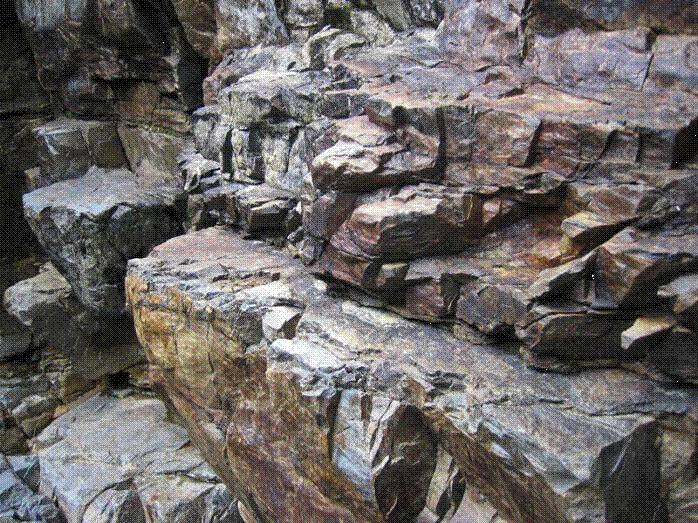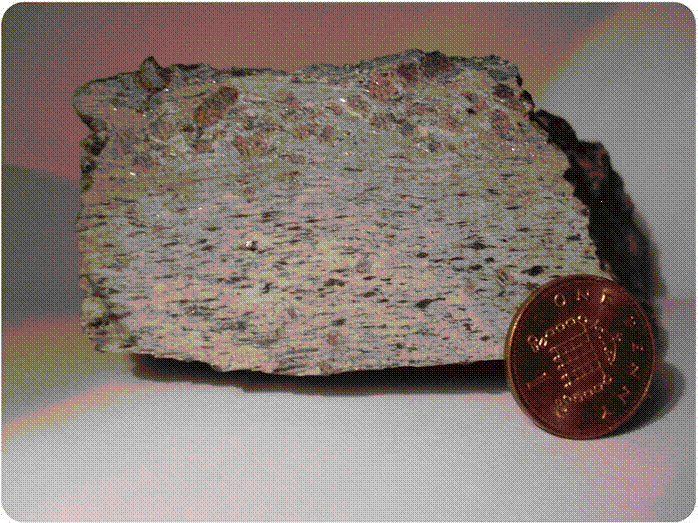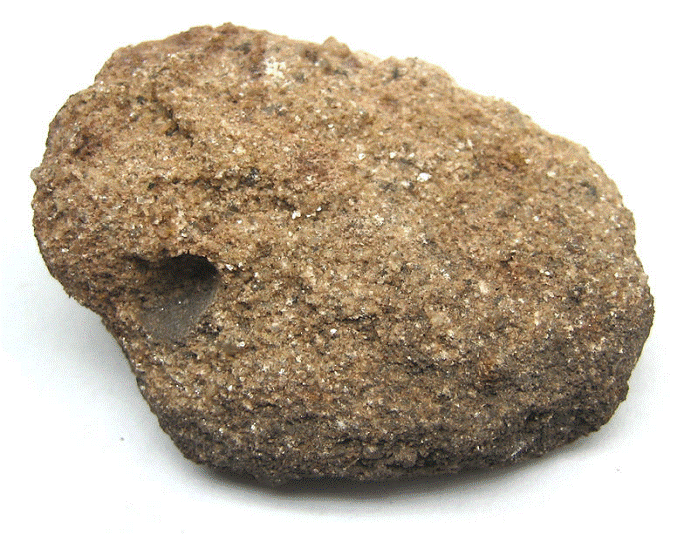Introduction to Rocks
Classification
of Rocks by origin.
Unlike climate which is classified
according to characteristics or similarities, rocks on the other hand are
distinguished on three ways:
(a)
Origin. This appears to be the most important method because most rocks
tend to originate from given compounds, as a result of a given forming
processes.
The most common compounds in which rocks
are usually formed include iron-oxides, calcite, dolomite clay, quartz and
feldspars groups of varying percentages and degrees.'

This life-size elephant is carved from
granite.
(b)
Age. Despite the facts that different rocks exist simultaneously at given
places they still vary in age. There are those which are old while others are
young. There are even those which are in the process of making and yet some
have to be made!
(c) Characteristics.
Rocks can also be classified according to their characteristics. Rock of given
age and mode of formation tend to be uniform. This method of classification
emphasizes mainly the rock resistance.

From, these two methods rocks can be
classified into three main types which include:
Igneous
Rocks
Igneous rocks are rocks that have been
formed through ignition process. The process of ignition involves fire. This is
why they are referred to as fire formed rocks.
The process ignition is two fold and as
such there are also two forms of rocks, namely
(a)
Volcanic. These are rocks that result from out pouring lava which reaches
the surface and congeals. This process is referred to as extrusion or simply
volcanism.
(b) Plutonic.
These are rocks which have solidified deep in the earth's crust, when lava
fails to reach surface but after sometime they
gradually reach the surface through erosion.

Granitic
rock type provides a very good example of such
rocks. The two types of rocks as described above are jointly formed through the
process known as Vulcanism. Through this process the
molten magma (hot lava) erupts through the lines of weakness and depending upon the driving force it can either remain
underground or reach the surface where it cools and solidifies. These processes
are in the order of intrusion and extrusion. There are three distinct forms of
Igneous rocks: Plutonic, hypabyssal and volcanic. Each of these rocks is unique
in almost every aspect despite the fact they are formed through the same
process. For instance:
Plutonic
This form of rocks are formed deep under
ground and usually cool much slower. This is why the crystals making them are
quite large in size.
Examples are granite, gabbro, diorite,
syenite and peridotite.
Hypabyssal
These are rocks which are superficial, i.e.
found near the ground surface. They contain crystals which are neither small
nor big because they cooled moderately. Examples: granophyre, poryphries,
dolerite
Volcanic
These are rocks which are formed at the
ground surface. They are the rocks which cooled very fast because of low
temperatures existing in the earth, surface.
This rate of cooling is the reason why
such rocks have small crystals which are almost fine. Additionally Igneous
rocks generally have a high percentage of silica and this is the reason why
they can exist as acidic as well as basic. This is shown by the extent of their
sizes and trend on the earth surface. Examples: Basalt, Andesite, Rhyolite,
Obsidian.
In
Metamorphic
rocks
The term “meta” means change and morphic
means “form”. Thus they are rocks whose original composition has been altered
through number of other, processes. Metamorphic rocks can either be
sedimentary, another rock type or simply Igneous so long as their chemical as
well, as physical composition is changed. Rock metamorphism, is a process, in
which a rock is changed from its original composition to the new.

This mica schist is a metamorphic rock.
It was changed from a sedimentary rock like shale.
It
is applied in the same way as it is used to describe changes in the life
history of an insect like a butterfly.
These types of rocks usually have the
characteristics:
They are the hardest of the three
types.
They contain coarse crystals
They tend to be more resistant to
denudation processes and even to high temperatures than the other two. This is
because firstly, they are extremely complicated due to the processes in which
they could have been formed.
Secondly, are often solid, heavy,
massive and above all compact. They do not always have joints or faults.
Metamorphic rocks are formed in many
ways. The following are some of them:
By
compression.
Compression in the earth crust can be
brought in several ways which can include:
(a) When the overlying rocks compress
rocks below them
(b) When rocks move against each other
through sliding or due to earth movements. In either way heat is always produced.
This heat makes the minerals in the rocks to react and as a result lead to
their chemical as well as physical weathering.
By heating,
Again there are several ways in which a
rock can be heated. For instance .3
a. directly from
the sun through insolation.
b. During the processes
of folding, faulting, warping, earthquakes, volcanism, etc.
c. When a rock
comes in contact with a hot magma;
d. direct fire
heating;
The net result of these effects is the production
of heat which makes the rocks in contact to react and change their chemical
composition.
By
chemical and water action
In addition to heat and pressure, the
effect of acids and water is equally very significant in bringing about rock
metamorphism. This is because both of them are capable of reacting with a rock
by dissolving weak ones and even carrying away in solution. This is usually
very common in areas underlain by limestone and dolomite.
In east
1.
The Ankole surface
2.
Outcrop rocks e.g. the inselbergs such as Akisim,
Iriri south Karamoja; Soroti hill; the rock outcrop on the Koja peninsula at
the lake shore Basin.
3.
The Parabongo hill complex in northern
4.
The flat-topped hills of Buganda Province of Uganda.
5.
The escarpment or steep slopes found in the Rift valley
6.
The exposed granitic intrusion of the sukumaland near
3. Sedimentary rocks.
These are deposited or laid down rocks by
the agents of deposition. The agents doing this remain, water, ice, wind,
waves, etc.
Sedimentary rocks result from the rock
waste which is eroded from somewhere and later deposited by the same agents in
a most suitable place which is usually low or flat. As such rocks of this type
are never uniform in content.
Like the two other rock types,
sedimentary rocks have also defined characteristics. These include:
§ They contain a
lot of fossilised life.
§ They usually
occur in the form of layers which have been squeezed, cemented and hardened by
the pressure of the overlying rocks.
§ The rocks are
not uniform in character;
§ They are most
youngest of the three because the process of deposition is continuous.
§ Less resistant
of the three types of rocks. This is why agriculturally they are easier to
cultivate, and in addition are fertile.
Sedimentary rocks are mainly/ formed in
three ways. Through these methods, it has been possible to classify these rocks
clearly and in, a manner that it is easy to explain and describe. These
include:
Physically
or Mechanically formed

These are rocks which are formed
mechanically through the effect of:
Wind
deposition. As wind blows it erodes rock, transport it and later deposits. In
areas where wind activity is much, like deserts rock accumulations are
produced. The loess found in the desert areas provide very good example on
this. Other examples include:
a) Arenaceous. The material that constitutes this
type is usually sand, sandstones and Grit.
b) Argillaceous. Under this category the following are
found: Mud, Clay, Mudstone and shape.
c) Rudaceous. Under this category we find the
following: breccia, Conglomerate, tillite, gravel scree, boulder: clay (principles
of physical Geography by F.S.Monkhouse).
Riverine
sedimentation. Rivers are one of the world's most important agent of erosion and
deposition. Along river valleys the following are usually found clay, gravels, pebbles,
boulders/and alluvium.

This sandstone is an example of a
sedimentary rock. It formed when many small pieces of sand were cemented
together to form a rock.
Glacial
deposition. "Like rivers, glaciers are also often associated with the
following deposits; moraines, sand, shingle, gravel and- boulder clay.
Organically
formed
These rocks are mainly composed of the
accumulated remains of the ancient living organisms. There are two sources in
which such rocks have been formed.
From
sea animals. The most important of these are the polyps which live in warm
ocean water of tropical lands.
The following rocks are products of
them: chalk and coral, the coral reefs at the East African coast provide a good
example of this type of rocks.
From
plants. When plants die and get buried underground, they form deposits
of rocks which at times are proved valuable. Some of such rocks include coal
and lignite. Peat, marsh or bog are other forms of these rocks.
Chemically
formed
These are rocks which are chemically
formed. Chemically formed rocks result mainly from the following processes;
(i) Leaching
(ii)
Evaporation and
(iii)
Precipitation from the solutions of salts.
In tropical areas such rocks are common
especially in the areas underlain by calcareous rocks such as limestone.
They form mainly through leaching in the
following ways:
When rain falls the rock gets dissolved
and form a solution which is leached into the ground. The mineral precipitates
formed are deposited and hardened with time.
During the process of evaporation at the surface
these minerals are again reversed to the surface where they are left as the
moisture in them evaporates. In
Summarily chemically formed rocks are usually
:formed through the following ways:
Through
chemical precipitation. The most important of this processes is leaching
especially; in the areas underlain by calcareous rocks such as limestone. In contrary, some rocks particularly calcite
have "been deposited directly on the beds of streams underground in the
system referred to as caverns. Tlxe nend result has been the
formation of chemical deposits in the form of stalactites, stalagmites and
pillars. This is especially important in the areas having rocks that contain
calcium carbonates,
Through
soil creatures.
Rocks can also be derived from organisms such as
ants, termites and polyps. Polyps are probably the most important for they
produce extensive accumulations of rocks called coral reefs. The other animals
also .produce but smaller relief features called earthmounds or anthills.
Through
mechanical processes:
Though chemically produced, sedimentary
rocks are also indirectly produced mechanically through the processes of
erosion and mass wasting by agents of erosion; As a rock is weathered it is
exposed to the effect of weathering. Through this process the rock is further
broken into much more small particles as they get deposited somewhere.

Cobbles pebbles and sands are the
sediments that are seen on this beach.
Through
cementation.
This is a process also significant in
forming sedimentary rocks. It involves squeezing and compaction of the mineral
using mainly silica, carbonates and Iron oxides. These cementing agents are
generally referred to as sesguioxides. The most common rocks produced are
called duricrusts or hardpans. In
Compression.
Continued layering of the rocks by
agents of deposition often also result to the formation of this type of rocks.
One good example of this type is tufa which is often formed if the calcareous
substance is spongy. The most common of this is the deposits that contain
fossilised lives of algae or mosses.
In
§ the lake shores where, sediments are brought by rivers
flowing into the lakes,
§ Swamps: This can be brought through river flooding.
§ Valleys: The main agents can be:
(i) Mechanical weathering i.e.
exfoliation.
(ii) Mass wasting
(iii)
Rivers and streams flowing towards the valley floor from the highlands.
§ Coastal areas: Mainly by river discharge from inland. Waves,
currents and tides are the main agents of deposition
in these regions.
(d)
Intrusive into the Palaeozoic and Mesozoic rocks.
Intrusive made up of ijolites,
meltegites and nepheline syenites with associated dykes cut through rocks of
Karoo age at Jombo, while carbonatite intrusions occur nearby at Mrima, Nguluka
and Kiruku (all in
Other intrusives in Tanzania include
basic and ultra basic rocks of Matumbi hills south of Utete (Rufiji-Ruhuhu
valleys), a dolerite dyke at Mbarali,
and in the Rufiji river area are plugs and dykes of phonolite, andesite and
basalt. Cimberlite intrusions occur in northern
Cainozoic
Rocks.
Cainozoic period is divided into:
(a)Tertiary
period.
(b) Quartenary
period.
During these periods, the greater part
of
(a)There was
protracted sub aerial erosion (denudation)
(ii)There was
widespread tectonism (earth movements).
(iii)There was
extensive igneous activity (Vulcanism).
Denudation
during Tertiary period produced continental deposits and peneplains. In all
the East African Countries, Sands,
Sandstones, Limestones, conglomerates, mudstones, silts were deposited. Alkaline
lavas and pyrocclasts were also produced by volcanic activity.
During Quaternary period, there was
major faulting in the Western rift valley, while in the rift valley, renewed
faulting took place. Faulting was associated with volcanism especially the Bufumbira volcanism), explosion craters
in Fort Portal and the intrusion of carbonatite
complexes along a line stretching from Mt. Moroto through Mt. Elgon, and
angwa to Homa in Kenya, and another one
at Jombo and Mrima south of Mombasa, and migu and Majiya Wela in Tanzania.
Other volcanics include alkaline intrusions (and cones such as
Quaternary deposits includes the
Kaiso-Kasenyi beds in the Lake George - Lake Edward basins and the Semlike deposits in
The Semliki deposits in the Albert rift
is thought to be over 2400 Metres thick while the Kaiso beds are about 1200 Metres thick. In
The Quaternary period is also
characterised by glaciation on the higher peaks (
Soils and alluvial deposits are
widespread in eastern)
The formation of
Understanding
the rock cycle

Processes of the Rock Cycle
Any type of rock can undergo changes and become any new
type of rock. Several processes are involved in the rock cycle that make this
possible. The key processes of the rock cycle are crystallization, erosion and
sedimentation, and metamorphism. Let’s take a closer look at each of these:
Crystallization. Crystallization occurs when molten
material hardens into a rock. An existing rock may be buried deep within the
earth, melt into magma and then crystallize into an igneous rock. The rock may
then be brought to Earth’s surface by natural movements of the Earth.
Crystallization can occur either underground when magma cools, or on the
earth’s surface when lava hardens.
Erosion and Sedimentation. Pieces of rock
at Earth’s surface are constantly worn down into smaller and smaller pieces.
The impacts of running water, gravity, ice, plants, and animals all act to wear
down rocks over time. The small fragments of rock produced are called
sediments. Running water and wind transport these sediments from one place to
another. They are eventually deposited, or dropped somewhere. This process is
called erosion and sedimentation. The accumulated sediment may become compacted
and cemented
together into a sedimentary rock. This whole process of
eroding rocks, transporting and depositing them, and then forming a sedimentary
rock can take hundreds or thousands of years.
Metamorphism. Sometimes an existing rock is exposed to
extreme heat and pressure deep within the Earth. Metamorphism happens if the
rock does not completely melt but still changes as a result of the extreme heat
and pressure. A metamorphic rock may have a new mineral composition and/or
texture.
Note that the rock cycle really has no beginning and no
end: therefore, it’s a never-ending cycle. The concept of the rock cycle was
first developed by James Hutton, an eighteenth century scientist often called
the “father of geology.” Hutton spoke of the cyclic nature of rock formation
and other geologic processes and said that they have “no [sign] of a beginning,
and no prospect of an end.” The processes involved in the rock cycle take place
over hundreds or even thousands of years, and so in our lifetime, rocks appear
to be fairly “rock solid” and unchanging. However, a study of the rock cycle
shows us that change is always taking place.
The next three lessons of this chapter
will discuss each type of rock in more detail.